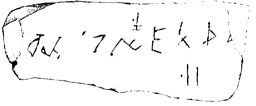 |
Science Frontiers ONLINE No. 63: May-Jun 1989 |
|
|
A New Look At The Bat Creek Inscription
 The Bat Creek Stone. Which side is up has been a problem! |
"The Bat Creek Stone has generated so much controversy, yet it was excavated in an undisturbed burial mound in 1889 under the direction of Cyrus Thomas, Project Director of the Bureau of American Ethnology's Mound Survey, a part of the Smithsonian Institution. There could be no question of forgery because it was found under the head of one of the nine skeletons that were excavated. Pieces of wood presumed to be the remains of wooden earspools were preserved in the Smithsonian's collections as were a pair of brass C-shaped bracelets. Thomas immediately declared the nine characters on the stone to be Cherokee and the burial assumed to be post-contact - what else could the bracelets be but trade items or native copper?"
That would seem to be the end of the story, but some language students failed to see any resemblance between the Bat Creek Inscription and the written Cherokee language. Further, C. Gordon, admittedly a proponent of early Phoenician contact with the New World, declared that the Bat Creek characters were Paleo-Hebrew, a family of languages that includes Phoenician. Then, in 1987, the wood accompanying the Bat Creek Stone was radiocarbon-dated in the range 32- 769 AD - definitely not "post-contact." Modern analysis was also applied to the bracelets, leading to the discovery that they had the same proportions of lead and zinc as the brass made by the Romans between 45 BC and 200 AD. In sum, the Bat Creek Stone now seems more likely to be something inscribed by early Phoenician visitors to North America.
(Strong, Roslyn; "A New Look at the Bat Creek Inscription," NEARA Journal, 23:26, Summer/Fall 1988. NEARA = New England Antiquities Research Association.)